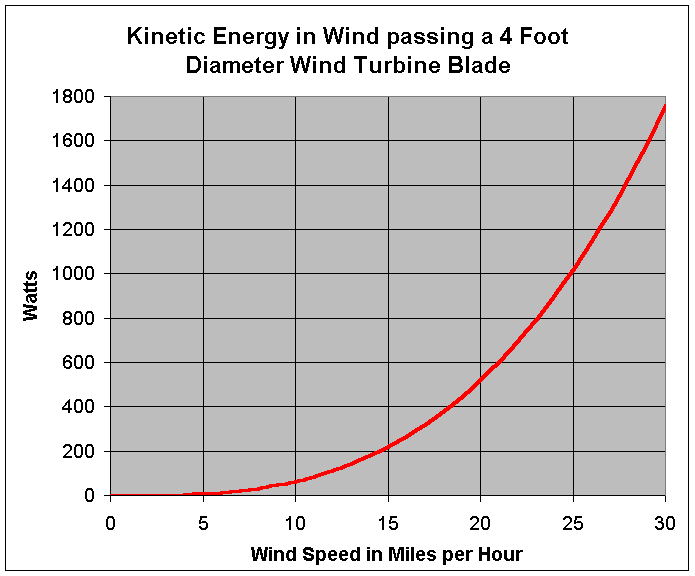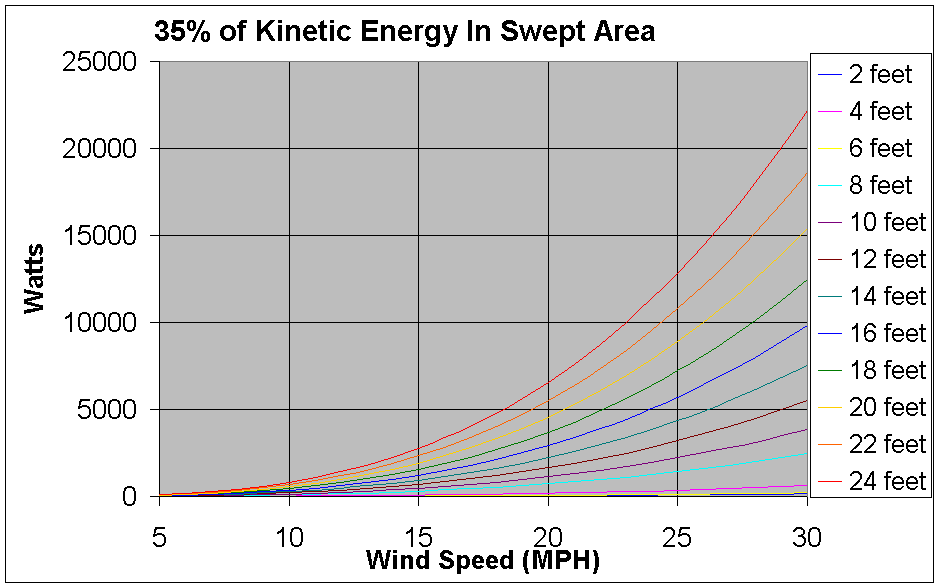
Below are some notes I made to myself while trying to understand wind power. I basically made these notes originally so that I could remember and learn the important theories. I cleaned them up a bit and compiled them into several documents, the first of which is below. They may still contain errors, or omissions. Richard Hagen
Power in the wind:
When we extract power from the wind using a wind turbine, we are basically taking kinetic energy from the moving air and converting it to kinetic energy of an air foil. There are other types of energy in the air, its internal energy, and pressure volume energy, which are affected slightly, but compared to the kinetic energy, these changes are minor, and we can essentially ignore them for our purposes.
The kinetic energy of a moving object is equal to one half of its mass multiplied by the square of its velocity.
The available power in moving air from kinetic energy is equal to one half of the mass of the air times the square of the velocity of the air. The magnitude of the velocity if it is facing into the wind is the wind speed.
One could calculate the total kinetic energy of the air available for extraction by a turbine rotor for a given wind speed relative to the turbine. For a horizontal axis turbine, the swept area is a circular area with a radius equal to the length of one blade. Since the area of a circle is equal to pi multiplied by the square of the radius, then the swept area = pi times the square of the blade length.
The volume of air moving through that swept area would be the wind speed, V, multiplied by the swept area.
The mass of the air in a given volume of air is that volume multiplied by its density since the density is the ratio of the mass to the volume.
The mass of air moving past a given point is then M = V*pi*(blade length)^2*(air density)
The total kinetic energy is then K = (1/2)*(V*pi*(blade length)^2*(air density))*(V)^2
K = 1/2*pi*(blade length)^2*(air density)*(V)^3
As an example, in a 10 mile per hour breeze, for a 4 foot diameter wind turbine, with an air density of 1.25 Kg per cubic meter (which is approximate for sea level dry air)
first we have to put everything into the same units. 4 feet = 1.2192 meters, the 10 mile per hour breeze is equal to about 4.47 meters per second
The kinetic energy per unit of time is then 1/2 * pi * (1.2192/2 m)^2*(1.25 KG/m^3) * (4.47 m/s)^3 = 65.2 Kg*m^2/s^3 and multiplying by one second yields an energy of 65.2 Kilogram meters squared per second squared, since one Joule is one Kilogram meter per second squared, this is 65.2 Joules of energy per second, and since one Watt is equal to one joule per second, this would be a continuous power of 65.2 Watts.
For 20 miles per hour, everything else the same we would have:
1/2*pi*(1.2192/2)^2*(1.25KG/m^3)*(4.47m/s*2)^3 = 521.4 Kg*m^2/s^3 = 521.4 Watts.
Effects of changes in air speed on the available power:
From the above we can see that the power is related to the cube of the air speed.
if the wind changes from a speed of V1 to V2, then the kinetic energy of a mass M of air at V2 would be equal to
1/2 *M * V2^2
The mass of air moving past a given point also changes. If the density of the air is constant, it changes linearly with the speed. If a mass M of air moves past a point at velocity V1, then a mass of V2/V1*M would move past at the final velocity.
The kinetic energy of the air moving past a point at V2 divided by the kinetic energy moving past a point at V1 (the ratio of the kinetic energies) would be
(1/2(V2/V1)*M*(V2)^2)/(1/2*M*(V1)^2) Simplifying, we get ((V2)^3/V1)/((V1)^2) and since V1/V1 = 1 we can multiply to simplify further and obtain (V2)^3/(V1)^3
This also shows is that the change in the kinetic energy in the wind moving past a point at constant density is directly proportionate to the cube of the wind speed.
If we took the above example of a 4 foot rotor and wanted to know the total available power at 20MPH then we could have also calculated it by multiplying the known value by this ratio.
65.2 Watts * (20)^3/(10)^3 = 521.6 Watts (which aside from rounding differences is the same as the amount calculated above.)
For the same turbine with a relative wind speed of 30 miles per hour we would have:
65.2 Watts * (30)^3/(10)^3 = 1760.4 Watts for the total kinetic energy of the air moving through its swept area
If one was to plot the total available kinetic energy vs. the wind speed for a 4 foot blade it would look like the chart below

The power in the wind isn't zero when the wind is below 5 Miles per Hour, it is just that it is so low that it appears that way. At 5 miles per hour it is about 8 watts, and at 4 miles per hour it is about 4 watts.
If someone were to claim better results than this, from a four foot diameter wind turbine, they would obviously be either mistaken, or lying, as the energy isn't there to convert, even if the machine was 100% efficient, which no machine is. In fact there are even further limits on performance. If one were to add the power produced curve of an actual wind turbine to the chart above, it would be significantly below the curve of the total energy available above.
If one could take all of the kinetic energy from the air, it would stack up at the wind turbine, with no energy to move downwind from the turbine. A fellow by the name of Betz did some study on this and figured that you couldn't do better than to extract about 59% of the total energy. Additionally, no mechanical system is 100% efficient, and no alternator is either. We are probably doing well if we get 35% of the available kinetic energy into our batteries. Variable speed wind turbines like the ones commonly built are usually optimized for a narrow range of wind speeds around the most prevalent wind speed, and obtain even lower efficiency outside of that range.
The below chart shows plots of 35% of the available kinetic energy versus the wind speed for a variety of rotor diameters. If you wish to replace a reasonable percentage of your grid power, and you live in an area with an average wind speed of 12 miles per hour, you need a relatively large machine. You also have to have a plan for what to do with all of the power you will generate during those rare periods of high wind in order to protect your machine.
